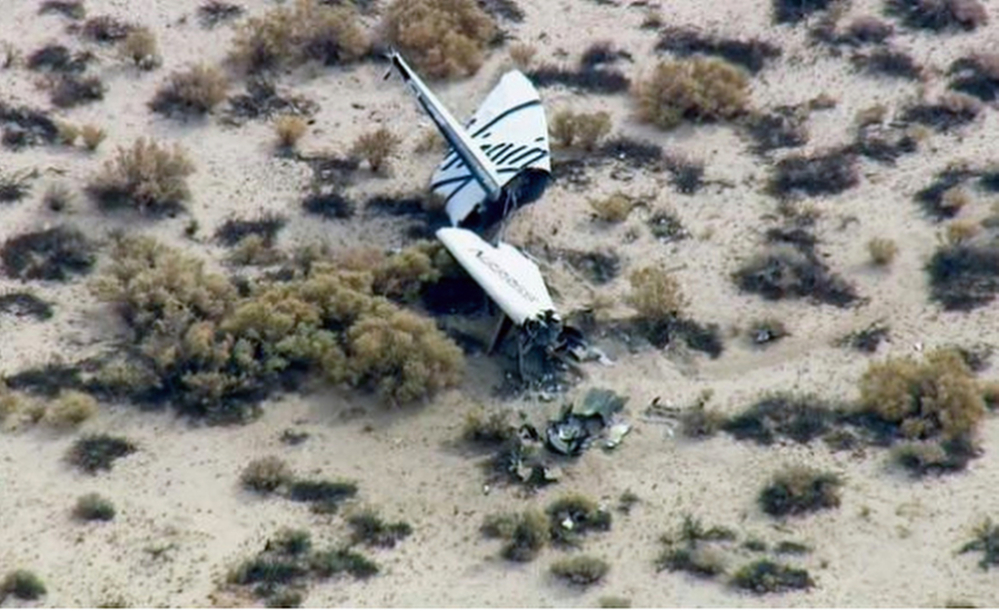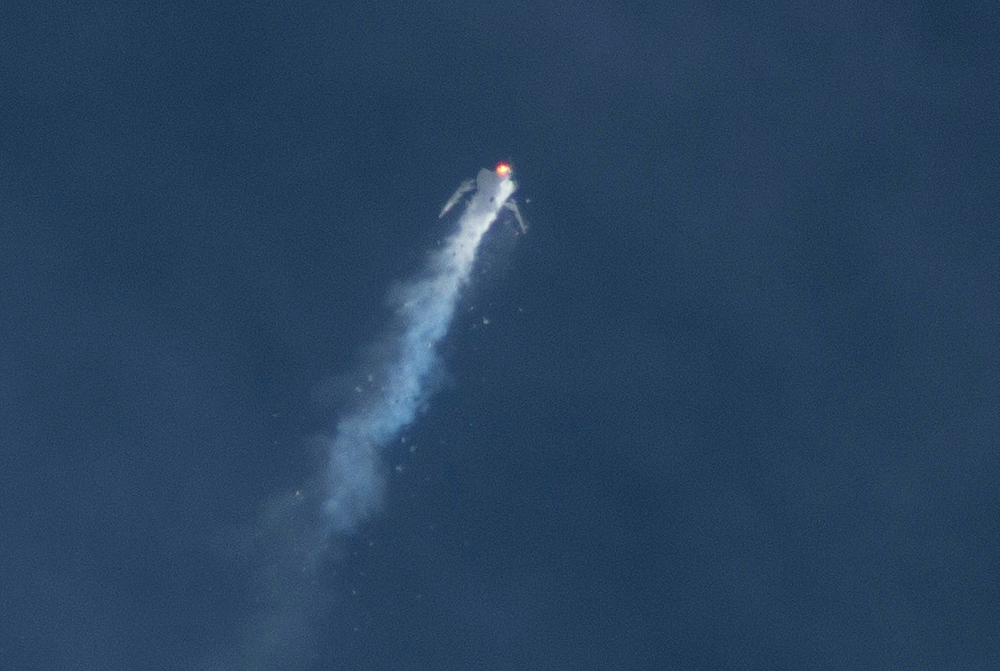MOJAVE, Calif. — A winged spaceship designed to take tourists on excursions beyond Earth’s atmosphere exploded during a test flight Friday over the Mojave Desert, killing a pilot in the second fiery setback for commercial space travel in less than a week.
Virgin Galactic’s SpaceShipTwo blew apart after being released from a carrier aircraft at high altitude, according to Ken Brown, a photographer who witnessed the explosion.
One pilot was found dead inside the spacecraft and another parachuted out and was flown by helicopter to a hospital, Kern County Sheriff Donny Youngblood said.
The crash area was about 120 miles north of downtown Los Angeles and 20 miles from the Mojave Air and Space Port, where the flight originated.
British billionaire Richard Branson, founder of Virgin Galactic, has been the front-runner in the fledgling race to give large numbers of paying civilians a suborbital ride that would let them experience weightlessness and see the Earth from the edge of space. Branson was expected to arrive in Mojave on Saturday, as were investigators with the National Transportation Safety Board.
“Space is hard, and today was a tough day,” Virgin Galactic CEO President George Whitesides said. “The future rests in many ways on hard, hard days like this.”
The accident occurred just as it seemed commercial space flights were near, after a period of development that lasted far longer than hundreds of prospective passengers had expected.
When Virgin Group licensed the technology from Microsoft co-founder Paul Allen, who put $26 million into SpaceShipOne, Branson envisioned operating flights by 2007. In interviews last month, he talked about the first flight being next spring with his son.
“It’s a real setback to the idea that lots of people are going to be taking joyrides into the fringes of outer space anytime soon,” said John Logsdon, retired space policy director at George Washington University. “There were a lot of people who believed that the technology to carry people is safely at hand.”
Friday’s flight marked the 55th for SpaceShipTwo, which was intended to be the first of a fleet of craft. This was only the fourth flight to include a brief rocket firing. During other flights, the craft either was not released from its mothership or functioned as a glider after release.
At 60 feet long, SpaceShipTwo featured two large windows for each of up to six passengers, one on the side and one overhead.
The accident’s cause was not immediately known, nor was the altitude at which the explosion occurred. The first rocket-powered test flight peaked at about 10 miles above Earth. Commercial flights would go 62 miles or higher.
One difference on this flight was the type of fuel. In May, Virgin Galactic announced that SpaceShipTwo would switch to a polymide-based fuel – a type of thermoplastic. It had been fueled with a type of rubber called HTPB.
Scaled Composites, the company building the spaceship for Virgin Galactic, had extensively tested the new fuel formulation on the ground, President Kevin Mickey said. He characterized the new fuel as “a small nuance to the design.”
Officials said they had not noticed anything wrong before the flight. The problem happened about 50 minutes after takeoff and within minutes of the spaceship’s release from its mothership, said Stuart Witt, CEO of the Mojave Air and Space Port.
Virgin Galactic – owned by Branson’s Virgin Group and Aabar Investments PJS of Abu Dhabi – sells seats on each prospective journey for $250,000. The company says that “future astronauts,” as it calls customers, include Stephen Hawking, Justin Bieber, Ashton Kutcher and Russell Brand.
The company reports receiving $90 million from about 700 prospective passengers.
Friday’s accident was the second this week involving private space flight. On Tuesday, an unmanned commercial supply rocket bound for the International Space Station exploded moments after liftoff in Virginia.
Virgin Galactic plans to launch space tourism flights from the quarter-billion-dollar Spaceport America in southern New Mexico once it finishes developing its rocket ship.
Taxpayers footed the bill to build the state-of-the-art hangar and runway in a remote stretch of desert in southern New Mexico as part of a plan devised by Branson and former New Mexico Gov. Bill Richardson. Critics have long challenged the state’s investment, questioning whether flights would ever get off the ground.
Send questions/comments to the editors.




Success. Please wait for the page to reload. If the page does not reload within 5 seconds, please refresh the page.
Enter your email and password to access comments.
Hi, to comment on stories you must . This profile is in addition to your subscription and website login.
Already have a commenting profile? .
Invalid username/password.
Please check your email to confirm and complete your registration.
Only subscribers are eligible to post comments. Please subscribe or login first for digital access. Here’s why.
Use the form below to reset your password. When you've submitted your account email, we will send an email with a reset code.